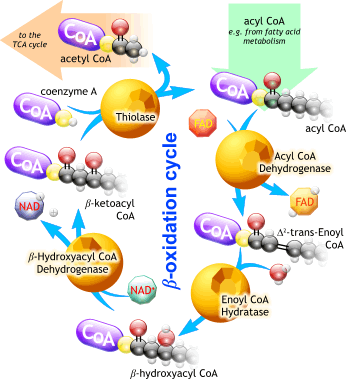Fats, fatty acids and fat metabolismThe majority (95%) of the fats in our food and also the fats stored in our body fat are triglycerides. A
triglyceride is made of one glycerol and 3 fatty acids. A fatty acid is made of 3 kinds of atoms: C (carbon), O (oxygen) and H (hydrogen). Fatty acids have 4 to 24 carbon atoms. Depending on the number of carbons they are called short chain fatty acids (C4 to C6), medium chain fatty acids (C6 to C12) and long or very long chain fatty acids (C12 and more).
Example of a fatty acid with 16 carbons (C16):
Fatty
acids can be burnt or oxidized in order to produce
energy. Activation of a fatty acidAs
soon as a fatty acid arrives in the cell, it first has to be activated. The oxidation of the acyl-CoA happens inside the mitochondria, so the activated fatty acids first have to be transported through the membrane to the inside of the mitochondrion. Transport of the acyl-CoAOnly the shorter acyl-CoA's can pass the membrane of the mitochondrion without any help. The longer acyl-CoA's (as of C10) need the help of a substance called carnitine.The acyl-CoA will drop its CoA and replace it by a carnitine. The result is an acylcarnitine that can be transported through the membrane of the mitochondrion. Once the acylcarnitine is inside the mitochondrion the carnitine is removed and replaced again by a CoA. The acyl-CoA is now ready for being metabolised. Metabolising of an acyl-CoA: beta-oxidationBeta-oxidation is a biochemical process that happens in 4 steps. For each step a specific enzyme is needed. Each time the end product of a certain step will be used as the starting product for the next step. The
enzyme needed for the first step is called acyl-CoA dehydrogenase.
There are 4 versions of this enzyme: one for short chain, medium chain,
long chain and very long chain fatty acids. The enzymes needed for the 3 other steps are not important with regard to MCAD deficiency and are not further discussed in this text. But they are mentioned on the image below that schematically represents the cycle of beta-oxidation:
The
end product of beta-oxidation after the 4th step is 1 acetyl-CoA and 1 acyl-CoA that is 2
carbon atoms shorter that the acyl-CoA that was started with. In this
process energy is released. The
acetyl-CoA
will be further processed by an other biochemical process (called the
citric acid cylce, Krebs cycle or TCA cycle). It can also be used to
produce ketones. See the pages on the fed-fast cycle for more information
about this. The acyl-CoA that was also the result of the beta-oxidation, will undergo the beta-oxidation process again. This cycle will continue until the fatty acid is completely metabolized. Medium-chain acyl-CoA dehydrogenase deficiency
MCAD
deficiency is a deficiency (not properly
working) of an enzym
called acyl-CoA dehydrogenase necessary for the oxidation of medium
chain fatty acids. This enzyme is called the MCAD enzyme elsewhere on this website.
|
||||
References
|


